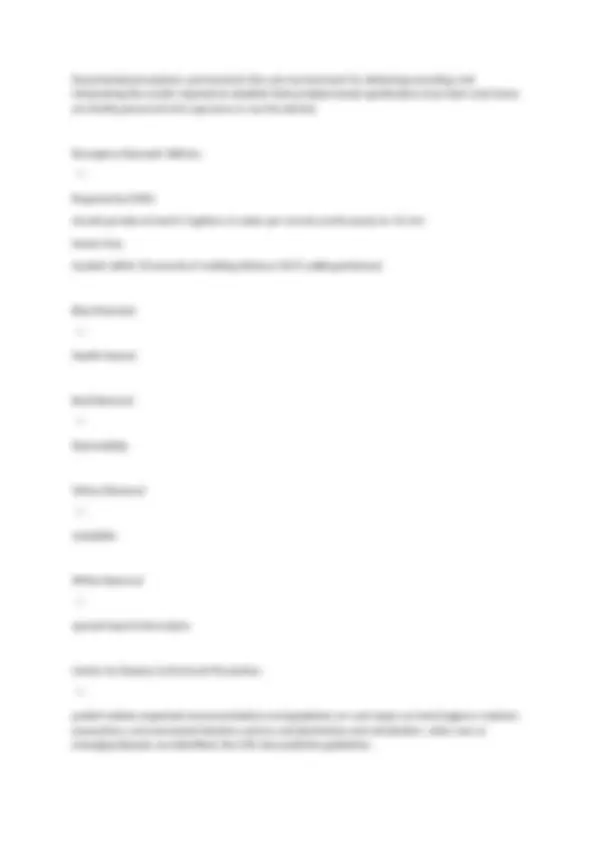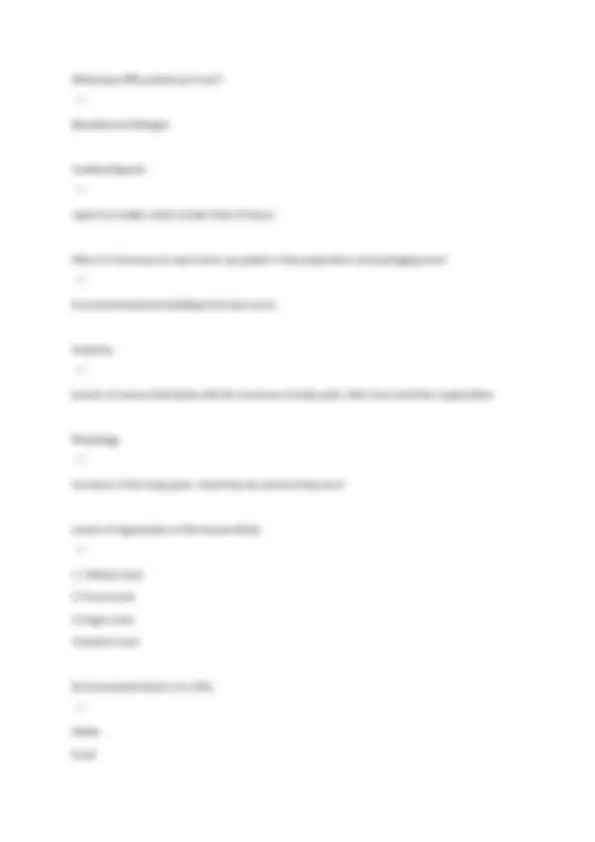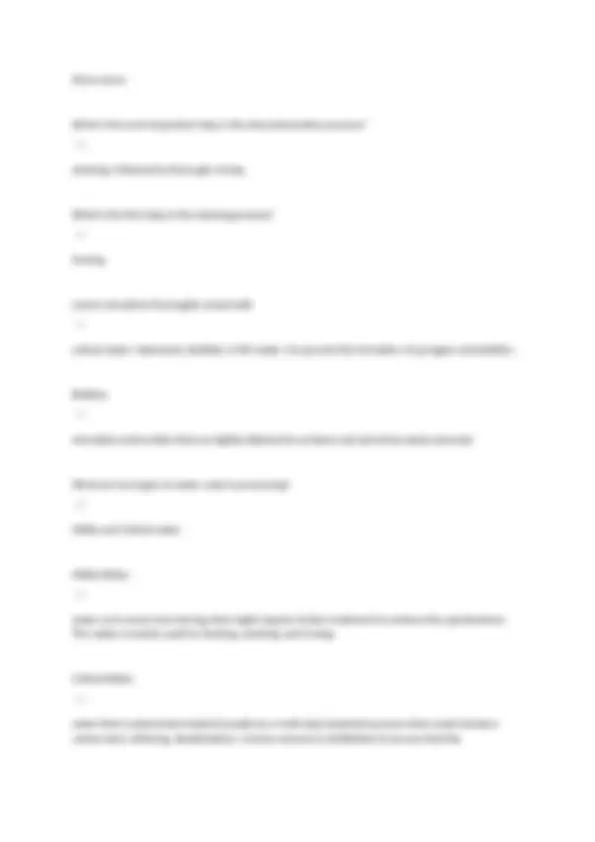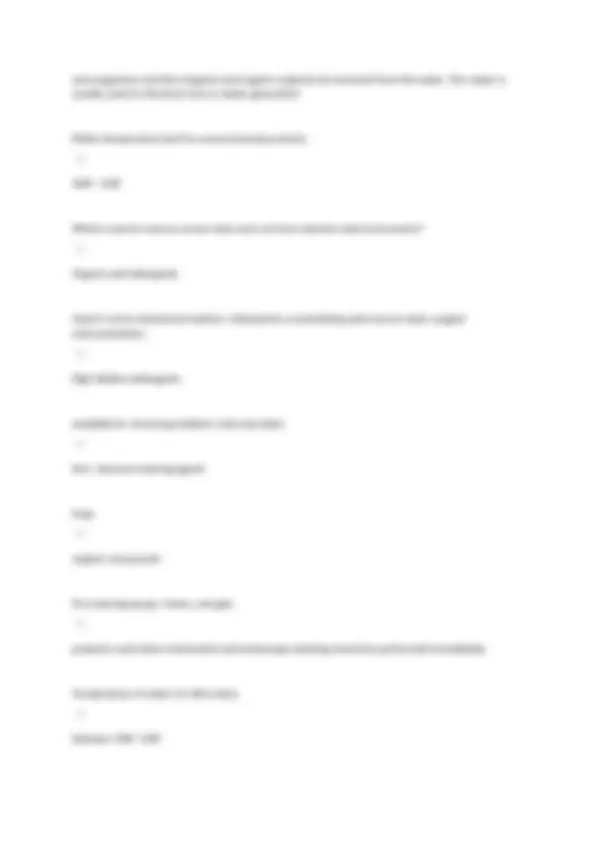








Study with the several resources on Docsity

Earn points by helping other students or get them with a premium plan


Prepare for your exams
Study with the several resources on Docsity

Earn points to download
Earn points by helping other students or get them with a premium plan
Community
Ask the community for help and clear up your study doubts
Discover the best universities in your country according to Docsity users
Free resources
Download our free guides on studying techniques, anxiety management strategies, and thesis advice from Docsity tutors
Sterile Processing Practice Exam 78 Questions and Answers Latest 2025
Typology: Exams
1 / 12

This page cannot be seen from the preview
Don't miss anything!







What exactly does the SPD do? **
controlling access to SPD ( who comes in and out ) Who requires SPD facilities to be prepared for disasters? ** The Joint Commision Hippocratic Oath ** the ideal of doing no harm to another person Regulations ** a principle, rule or law designed to control or govern behavior Standard ** is an established norm determined by opinion, authority, research, and/or theory Recommended Practices ** statements of sound principles of practice that are based upon scientific data and the opinions of experts Validation ** documented procedure for obtaining, recording, and interpreting the results required to establish that a process will consistently yield product complying with predetermined specification. Validation is performed by MANUFACTURERS, not the end user User vereification **
Fire Extinguisher Class A ** cloth, wood, paper, rubber, and many plastics Fire Extinguisher Class B ** gasoline, alcohol, diesel oil, oil-based paints, lacquers, etc.. flammable gases Fire Extinguisher Class C ** Energized Electrical Equipment Fire Extinguisher Class D ** magnesium, titanium, and sodium Fire Extinguisher Class K ** Vegetable oils, animal oils, or fats in cooking appliances. This is for commercial kitchens, including those found in restaurants, cafeteria, and caterers. Fire Triangle ** Fuel Source, Oxygen Source, Ignition Source
What does PPE protect you from? ** Bloodborne Pathogen Incident Reports ** report no matter what no later than 24 hours Why is it necessary to wear warm up jackets in the preparation and packaging area? ** to prevent bacterial shedding from bare arms Anatomy ** branch of science that deals with the structure of body parts: their form and their organization Physiology ** functions of the body parts: what they do and how they do it Levels of Organization of the Human Body **
Skull ** which is composed of the cranium and the facial bones. The smallest bones of the body are found in the middle ear; these bones are called the anvil, the hammer and the stirrup because that is what they look like Hyoid Bone ** located in the neck between the lower jaw and the larynx. It supports the tongue and functions in swallowing Vertebrae Column ** composed of approximately 26 ring shaped bones called vertebrae, which are separated by cartilaginous, intervertebral disks. The vertebral column consist of the lumbar, thoracic, and cervical spine Thoracic Cage ** composed of the sternum and 12 pairs of ribs. It protects the organs of the thorax (chest) and the upper abdomen. Pectoral Girdle ** formed by the scapula (shoulder blade) and clavicle on each side of the body. It connects the bones of the arms and aids in arm movements Bones of the Upper Limbs ** Humerus, Radius, and the Ulna in each arm. These three bones connect and move with each other at the elbow joint. At the distal end of radius and ulna are the eight carpals of the wrist. The bones of the palm are called metacarpals, and the finger bones are called phalanges
Pelvic Girdle ** connects the bones of the legs to the axial skeleton and , with the sacrum and coccyx (tail bone), form the pelvis, which protects the lower abdominal and reproductive organs Bones of the Lower Limbs ** Femur (thigh bone), the tibia and the fibula in each leg Bioburden ** microorganism on a contaminated item Decontamination temp and humidity ** 60f-65f and 30%-60% AAMI recommends to use "Procedure Barriers" when ** physical barriers are not available For PPE, what should be donned first? ** Shoe covers For PPE, what is donned last? ** Gloves For PPE, what should be removed first? **
microorganism and the inorganic and organic material are removed from the water. This water is usually used for the final rinse or steam generation Water temperature best for enzyme-based products ** 109f - 140f What is used to remove severe stain and rust from stainless steel instruments? ** Organic acid detergents Used in some mechanical washers, followed by a neutralizing acid rinse to clean surgical instrumentation. ** High alkaline detergents available for removing stubborn soils and stains ** Non- abrasive cleaning agents Soap ** organic compounds Pre-cleaning sprays, foams, and gels ** products used when instruments and endoscope cleaning cannot be performed immediately Temperature of water for Ultra-Sonic ** between 100f -140f
If an endoscope is stored according to the recommendation, scientific consensus is that contamination will be negligible for up to how mandays? ** 14 days of storage, after 14 days will need to be reprocess Where is High Level Disinfection performed? ** Prep and packaging area What are QUAT's effective against? ** gram negative and gram positive bacteria What are QUAT's ineffective against? ** Lipid viruses and spores Whats the amount of time that an item must be in contact qith QUAT in order for it to be effective ** ranges from 3-10 min Halogens ** oxidizing agents that have the ability to remove oxygen from the molecules that make up most living things. Phenolics ** carbolic-acid-based products. They are effective against vegetative bacteria , fungi, and certain mycobacteria, but not against bacterial spores and some viruses. Alcohol